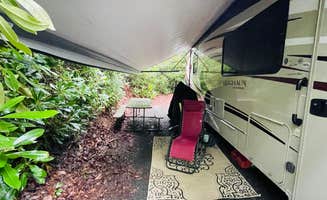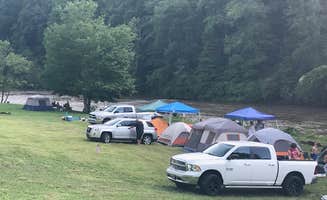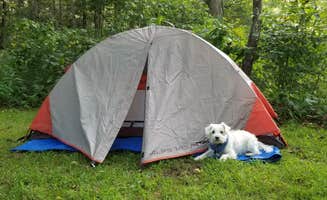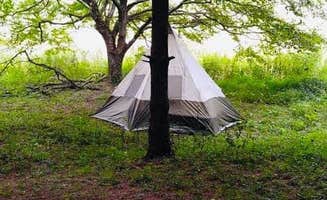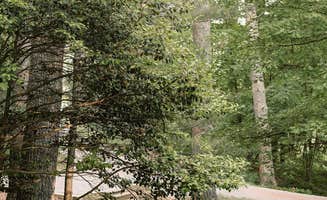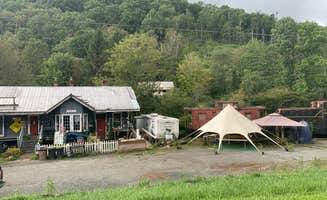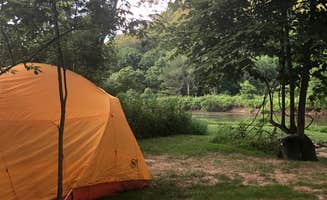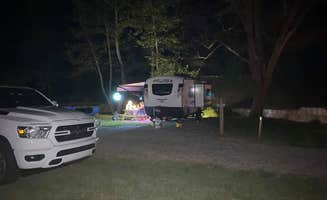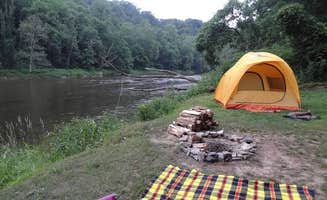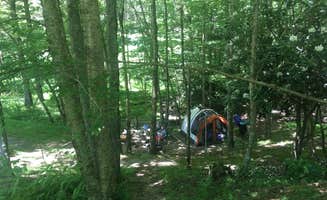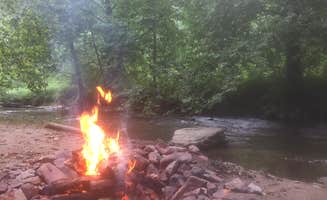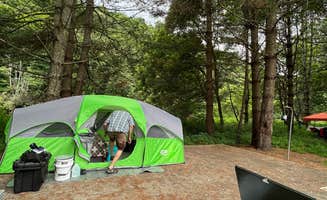Camping opportunities near Glendale Springs vary from small backcountry sites to larger established campgrounds, with elevations ranging from 1,200 to 3,800 feet throughout the area. The region sits at the intersection of the Blue Ridge Mountains and the New River watershed, creating distinct microclimates between valley and ridge camping locations. Temperature differentials between ridge and valley campsites can reach 15°F during summer months.
What to do
Trail access from camps: Hickory Ridge Campground provides immediate access to multiple hiking paths. "Great hikes and area for the family. Beautiful scenery and some great swimming holes," notes a Stone Mountain visitor. Many trails are accessible directly from campsites, eliminating driving to trailheads.
Fishing opportunities: Campers at waterfront sites often fish directly from their campsites. "We caught a trout in the pond right away," reports a visitor to Blue Bear Mountain Camp. Access to stocked waters is available year-round at some locations, though seasonal regulations apply.
Stargazing conditions: The higher elevation campgrounds offer excellent night sky viewing with minimal light pollution. "I was very much hoping to take photos of the night sky, but there was a storm with wild winds and cold," explains one camper at Hickory Ridge. The best viewing conditions typically occur September through November when humidity levels drop.
What campers like
Campsite privacy: Stone Mountain State Park Campground offers sites with natural screening. "We camped at RV site 40 and I think it's the best. There's a roaring large creek that flows behind the site and a grassy field full of deer beside it," one visitor shares. Distance between sites varies significantly across the region.
Water features: Many campers specifically choose sites with water access. At Twin Rivers Family Campground, "Our site (#3) was right on the New River. There are some permanent sites, tent sites, RV sites, and several primitive sites." Water proximity provides both recreational opportunities and natural white noise.
Cooler temperatures: The region's higher elevations provide relief during summer months. "The elevation is high so weather is nice for those trying to escape the summer heat," notes a visitor to Blue Bear Mountain Camp. Another camper adds, "70-80 in July!" Temperature advantages are most noticeable June through August.
What you should know
Access considerations: Several campgrounds have challenging entry roads. A Blue Bear Mountain Camp visitor warns, "The state maintained gravel road used to access campground was narrow and would be difficult to get a large camper up there, although there were lots of large ones there." Road conditions worsen after heavy rainfall.
Seasonal availability: Fort Hamby Park operates seasonally like many area campgrounds. "We camped there toward the end of October 2018. Campsites are level and plenty long enough. Bathhouse was extremely clean," reports one visitor. Most primitive sites close by early November, while some developed campgrounds remain open year-round.
Wildlife management: Bears are active in the region. At Doughton Park, "We were told by a ranger we talked with earlier in the day that this campground might be closed for the season but the gates were open." Another camper mentions, "This was the only place we saw bears but not in our campsite just wandering in another loop." Proper food storage is mandatory.
Tips for camping with families
Kid-friendly campgrounds: Raccoon Holler Campground offers extensive family activities. "Family-friendly campground with plenty of fun activities for kids. Playground, fishing pond, disc golf, recreation and game area, and ice cream trailer," notes one visitor. Most family-oriented sites require reservations 2-3 months in advance during peak season.
Swimming options: Several campgrounds feature water access for swimming. A Fort Hamby visitor shares, "It was quite hot, so we spent some time at the nice lake beach that is part of the park. A good spot to cool off!" Swimming areas are typically unguarded, and some require short hikes from campsites.
Interactive nature programs: Some parks offer ranger-led activities for children. At Hickory Ridge, "Plenty to keep kids and adults alike entertained, whether it's exploring the homestead area, looking for ponies, taking short hikes, geocaching, or playing games on the open field area." Program schedules vary seasonally and by day of week.
Tips from RVers
Hookup variations: Wagoner — New River State Park offers diverse hookup options. "Small campground with a handful of FHU sites. Some sites have patio area on 'wrong' (street) side instead of curb side, so take a look at Google satellite map when booking. Sites 3, 7, 10 are among the best," advises one RVer. Site orientation affects awning deployment and outdoor living space.
Leveling challenges: Terrain throughout the region creates leveling issues. At Raccoon Holler, a camper notes, "The site is not very level and very tight for my 32 foot RV." Another explains, "Getting parked was a bit of a challenge to get things as level as possible and work around power stand and be able to get awning out." Carrying extra leveling blocks is recommended.
Dump station access: Several campgrounds offer dump stations with varying availability. "Nice looking camp in a beautiful area. Didn't stay but did use the dump station for $17, so wanted to update info," mentions a visitor to New River State Park. Year-round dump stations are limited, especially during winter months when water systems may be winterized.


